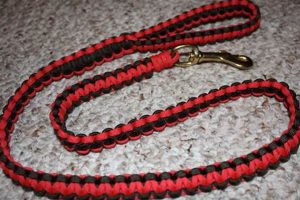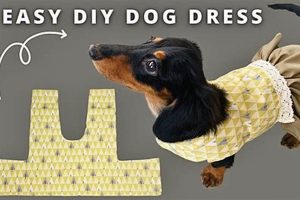The process of creating homemade solutions aimed at alleviating pruritus in canines constitutes a significant area of pet care. This approach encompasses a range of methods and ingredients, often utilizing readily available household items to address the discomfort associated with itchy skin in dogs. For example, a solution might involve combining oatmeal and water to create a soothing paste applied topically.
Formulating remedies at home provides pet owners with greater control over the ingredients used, potentially minimizing exposure to harsh chemicals or allergens found in commercial products. Historically, utilizing natural ingredients for pet care has been a common practice, passed down through generations. Furthermore, crafting personalized solutions allows for adjustments based on the specific needs and sensitivities of the individual animal, leading to potentially more effective outcomes and cost savings.
The remainder of this discourse will address specific techniques for formulating these at-home solutions, providing detailed recipes and application guidelines. Attention will be given to identifying potential irritants and selecting appropriate ingredients for various skin conditions. Safe handling practices and preventative measures will also be covered to ensure the well-being of the animal.
Guidance on Formulating Canine Pruritus Alleviation Solutions at Home
The following suggestions are intended to inform the responsible creation and application of at-home treatments to mitigate canine itching. Diligence in observation and adherence to veterinary advice remains paramount.
Tip 1: Identifying the Underlying Cause: Before initiating any treatment, determine, to the best of one’s ability, the etiology of the itching. Allergies, parasites, or skin infections may necessitate veterinary intervention rather than home remedies alone.
Tip 2: Oatmeal Bath Preparation: Colloidal oatmeal possesses soothing properties. Finely ground oats can be added to lukewarm bathwater. Allow the canine to soak for ten to fifteen minutes, ensuring the water is not too hot, as this may exacerbate the condition.
Tip 3: Coconut Oil Application: Virgin coconut oil exhibits moisturizing and anti-inflammatory characteristics. It can be applied topically to affected areas in small quantities. Ensure the canine does not ingest excessive amounts, as this may cause gastrointestinal upset.
Tip 4: Apple Cider Vinegar Rinse (Diluted): Apple cider vinegar, diluted with water (typically a 50/50 solution), can help restore the skin’s pH balance. Avoid use on open wounds or areas of broken skin. A patch test is recommended to check for adverse reactions.
Tip 5: Chamomile Tea Rinse: Brewed chamomile tea, once cooled, can be used as a rinse. Chamomile contains compounds that may reduce inflammation and soothe irritated skin. Ensure the tea is caffeine-free and unsweetened.
Tip 6: Dietary Considerations: Certain dietary changes may influence skin health. Consult with a veterinarian regarding potential food sensitivities or allergies. Omega-3 fatty acid supplementation may also be beneficial.
Tip 7: Regular Grooming Practices: Consistent brushing removes loose fur and dander, which can contribute to itching. Select a brush appropriate for the canine’s coat type to avoid skin irritation.
The effective utilization of these techniques requires careful observation and an understanding of the individual canine’s sensitivities. Should symptoms persist or worsen, immediate veterinary attention is advised.
The following sections will explore ingredient sourcing and potential safety precautions to further guide the responsible application of these techniques.
1. Ingredient Safety
The application of at-home remedies for canine pruritus necessitates a rigorous evaluation of ingredient safety. The physiological differences between canines and humans dictate a distinct approach to material selection, ensuring efficacy without causing unintended harm. The subsequent discussion outlines key considerations in determining the safety profile of substances used in formulations designed to alleviate canine itching.
- Toxicity Levels of Essential Oils
Many essential oils, lauded for their therapeutic properties in human applications, exhibit varying degrees of toxicity in canines. Tea tree oil, for instance, is highly toxic to dogs and should be strictly avoided. Even seemingly benign oils, such as lavender or chamomile, should be used with extreme caution and in highly diluted forms. Improper use can result in neurological symptoms, gastrointestinal distress, or dermal irritation. Therefore, a thorough understanding of canine-specific toxicity levels is paramount.
- Allergenic Potential of Natural Substances
While “natural” is often perceived as synonymous with “safe,” numerous natural substances possess allergenic potential for canines. Oatmeal, a common ingredient in soothing baths, can trigger allergic reactions in some dogs. Similarly, certain herbs and plant extracts may cause hypersensitivity. Conducting a patch test before full application is crucial for identifying potential allergens and preventing widespread adverse reactions.
- Impact of Preservatives and Additives
Homemade formulations, lacking the synthetic preservatives found in commercial products, are susceptible to microbial contamination. Improper storage can lead to the proliferation of bacteria or fungi, which can exacerbate skin conditions. Additives such as honey or yogurt, while potentially beneficial, can also promote microbial growth. Strict adherence to proper storage protocols and the use of natural preservatives, such as vitamin E oil, is recommended.
- Dosage and Concentration Considerations
Even inherently safe ingredients can pose risks if used in excessive concentrations. Dilution is a critical step in ensuring the safety of at-home remedies. Apple cider vinegar, for example, can cause chemical burns if applied undiluted. Similarly, over-application of emollient substances, such as coconut oil, can occlude skin pores and worsen pruritus. Careful attention to dosage guidelines is essential for minimizing potential harm.
The preceding points emphasize the importance of meticulous research and responsible application when formulating at-home remedies for canine pruritus. A proactive approach to ingredient safety, informed by veterinary advice and a thorough understanding of canine physiology, is essential for ensuring the well-being of the animal.
2. Correct Dilution and Pruritus Mitigation in Canines
The practice of preparing homemade solutions for canine pruritus necessitates adherence to precise dilution standards. The concentration of active ingredients in these solutions directly influences both the therapeutic efficacy and potential adverse effects experienced by the animal. Insufficient dilution may lead to skin irritation, chemical burns, or systemic toxicity, while excessive dilution could render the remedy ineffective. The relationship between concentration and therapeutic outcome is therefore critical.
An illustrative example involves the use of apple cider vinegar. This substance, often cited for its potential to restore skin pH, contains acetic acid. When applied undiluted, acetic acid can cause significant dermal damage. Conversely, a highly diluted solution might fail to exhibit any discernible therapeutic effect. The optimal dilution ratio represents a balance between efficacy and safety. Similarly, essential oils, lauded for their anti-inflammatory properties, require careful dilution in a carrier oil to prevent dermal sensitization or systemic absorption. The selection of an appropriate carrier oil is also important to consider, some might be more irritative than others. For instance, some individuals might have irritation or reactions to essential oils, even when diluted, the carrier oil should be one that they could also tolerate.
Therefore, proper formulation mandates a comprehensive understanding of ingredient properties, potential risks, and established dilution guidelines. Veterinary consultation is advisable prior to the application of any at-home remedy, particularly those involving potentially caustic or allergenic substances. A measured approach to concentration adjustment, based on individual canine sensitivity and observed response, is crucial for responsible and effective pruritus management.
3. Application Method
The efficacy of at-home canine pruritus relief solutions is inextricably linked to the method of application. The chosen technique dictates the extent and duration of contact between the active ingredient and the affected skin, influencing absorption rates and overall therapeutic outcome. Incorrect application can render even the most carefully formulated remedy ineffective or, worse, exacerbate the underlying condition. For instance, a leave-on application suitable for localized irritation may be entirely inappropriate for widespread dermatitis, necessitating a full-body rinse.
Specific examples illustrate the importance of application method. A targeted compress, saturated with a diluted chamomile solution, can provide localized relief for hot spots, delivering sustained anti-inflammatory benefits. Conversely, a poorly executed oatmeal bath, involving water that is too hot or inadequate soaking time, may fail to adequately soothe the skin. Similarly, topical application of coconut oil, when applied excessively, can occlude pores and trap irritants, negating its intended moisturizing effect. Furthermore, the temperament of the canine must be considered. A skittish or aggressive animal may not tolerate certain application methods, such as prolonged soaking or direct rubbing, requiring alternative strategies like spray-on solutions or gentle rinses.
Ultimately, the selection of an appropriate application method is paramount to the success of at-home pruritus relief efforts. A thorough understanding of the product properties, the nature and extent of the skin condition, and the individual canine’s tolerance are essential prerequisites. Failure to prioritize this aspect can undermine the potential benefits of even the most well-intentioned at-home remedies. Observational assessments of application effectiveness, coupled with veterinary consultations, is crucial for adaptative refinement.
4. Underlying Causes
The effective application of do-it-yourself canine pruritus relief methods hinges critically on identifying the root cause of the discomfort. Symptomatic treatment without addressing the primary etiology may provide temporary respite but ultimately fails to resolve the issue and could potentially exacerbate the underlying condition. A thorough understanding of potential causes is therefore essential for informed decision-making regarding at-home interventions.
- Allergic Dermatitis
Allergic reactions to environmental allergens (atopy), food ingredients, or flea saliva are frequent culprits in canine pruritus. Atopy often presents seasonally, with symptoms intensifying during pollen-heavy periods. Food allergies may manifest as year-round itching, frequently accompanied by gastrointestinal distress. Flea allergy dermatitis is characterized by intense itching, particularly around the tail base. Effective at-home management necessitates identifying and minimizing exposure to the offending allergen, which may involve dietary changes, environmental modifications, or rigorous flea control measures. In many cases, veterinary intervention for allergy testing and management is required.
- Parasitic Infestations
External parasites, such as fleas, mites (e.g., scabies, Demodex), and lice, can induce intense itching and skin irritation in dogs. Flea infestations are readily diagnosed through visual inspection or flea comb examination. Mite infestations often require skin scrapings for microscopic identification. At-home treatments may include parasiticidal shampoos or topical medications, but veterinary-prescribed treatments are often more effective and safer, particularly for severe infestations. Furthermore, eliminating parasites from the environment is crucial to prevent re-infestation.
- Skin Infections
Bacterial or fungal infections can complicate pruritic skin conditions, leading to secondary inflammation and discomfort. Bacterial infections often manifest as pustules, crusts, or moist dermatitis (hot spots). Fungal infections, such as ringworm, typically present as circular areas of hair loss and scaling. While some mild infections may respond to antiseptic washes or topical antifungal creams, veterinary-prescribed antibiotics or antifungals are often necessary for effective resolution. Identifying and addressing the underlying cause of the infection, such as allergies or immunosuppression, is essential to prevent recurrence.
- Nutritional Deficiencies
Inadequate nutrition can compromise skin barrier function and increase susceptibility to pruritus. Deficiencies in essential fatty acids, vitamins, or minerals can result in dry, flaky skin and increased itchiness. At-home management may involve dietary supplementation with omega-3 fatty acids or a change to a high-quality, balanced diet. However, it’s important to rule out other underlying causes of pruritus before attributing the condition solely to nutritional factors.
In conclusion, successful implementation of do-it-yourself canine pruritus relief strategies requires a comprehensive assessment of potential underlying causes. While at-home remedies may provide symptomatic relief, addressing the primary etiology is paramount for long-term resolution. Veterinary consultation is strongly recommended to accurately diagnose the cause of pruritus and develop a tailored treatment plan, which may include a combination of at-home and veterinary-prescribed interventions.
5. Veterinary Guidance
The integration of professional veterinary advice is paramount to the responsible and effective application of at-home canine pruritus relief strategies. While the concept of do-it-yourself solutions may appear appealing, the inherent complexities of canine dermatology necessitate the informed perspective of a qualified veterinarian. This guidance serves as a critical safeguard against misdiagnosis, inappropriate treatment, and potential harm to the animal.
- Differential Diagnosis and Etiology Determination
Veterinarians possess the expertise to differentiate between various causes of canine pruritus, ranging from allergic dermatitis and parasitic infestations to skin infections and systemic diseases. Accurate diagnosis is essential for selecting the most appropriate course of action. At-home interventions may be ineffective or even detrimental if the underlying cause is not correctly identified. For instance, administering an oatmeal bath for a yeast infection may inadvertently worsen the condition. Veterinary diagnostic procedures, such as skin scrapings, allergy testing, and blood work, provide crucial information for targeted treatment.
- Appropriateness and Safety Assessment of DIY Remedies
A veterinarian can evaluate the suitability and safety of specific at-home remedies based on the individual canine’s medical history, breed predispositions, and current health status. Certain ingredients or application methods may be contraindicated in certain dogs due to pre-existing conditions, sensitivities, or concurrent medications. For example, the use of apple cider vinegar may be inappropriate for dogs with open wounds or severely inflamed skin. Veterinary guidance ensures that at-home treatments are aligned with the canine’s overall well-being and minimize the risk of adverse reactions.
- Dosage and Application Guidance
Even when at-home remedies are deemed safe, proper dosage and application are crucial for achieving therapeutic benefits without causing harm. Veterinarians can provide specific instructions on dilution ratios, application frequency, and duration of treatment, tailored to the individual canine’s needs. Improper dilution of essential oils, for instance, can lead to skin irritation or systemic toxicity. Veterinary guidance ensures that at-home remedies are used responsibly and effectively, maximizing their potential benefits while minimizing potential risks.
- Monitoring and Follow-Up Care
Veterinary oversight is essential for monitoring the canine’s response to at-home treatments and adjusting the course of action as needed. Regular check-ups allow the veterinarian to assess the effectiveness of the remedies, identify any adverse reactions, and modify the treatment plan accordingly. Failure to monitor the canine’s progress can result in delayed diagnosis of underlying problems or the persistence of ineffective treatments. Veterinary follow-up care ensures that the canine receives optimal care and achieves sustained relief from pruritus.
In summary, veterinary guidance forms an indispensable component of responsible do-it-yourself canine pruritus relief. It provides a foundation of accurate diagnosis, safety assessment, and personalized treatment recommendations, ensuring that at-home interventions are both effective and safe for the animal. The integration of professional veterinary expertise is not merely a recommendation but a prerequisite for ethical and informed pet care.
6. Observation crucial
The success of any do-it-yourself approach to alleviating canine pruritus is fundamentally predicated on astute observation. The canine’s response to implemented remedies serves as the primary data point guiding further action. Without diligent monitoring of the animal’s condition, the potential for both ineffective treatment and adverse reactions increases significantly. Cause-and-effect relationships must be carefully scrutinized: Does the implemented solution reduce scratching, or does it appear to exacerbate the irritation? The absence of objective evaluation renders the entire undertaking speculative and potentially harmful. The selection of appropriate remedies, adjustments to dosage, and timely cessation of ineffective or adverse treatments depend entirely on the owner’s capacity for close and continual observation.
Consider the application of a diluted apple cider vinegar rinse. While this remedy may be beneficial for some canines, others may exhibit increased skin redness, indicating an adverse reaction. Without careful observation, this negative response could be overlooked, leading to continued use and worsening of the condition. Conversely, a subtle reduction in scratching frequency after an oatmeal bath might signal initial efficacy, prompting the owner to continue the treatment while closely monitoring for further improvement. Similarly, changes in the canine’s coat condition, appetite, or overall behavior must be considered within the context of the implemented remedy. These factors provide crucial insights that inform subsequent decisions.
In conclusion, diligent observation forms the cornerstone of responsible do-it-yourself canine pruritus management. It provides the necessary feedback loop for optimizing treatment strategies, mitigating potential risks, and ensuring the animal’s well-being. By meticulously monitoring the canine’s response to implemented remedies, pet owners can maximize the likelihood of achieving effective and safe pruritus relief. When changes are identified observation should be the key factor to the plan adjustments.
Frequently Asked Questions Regarding At-Home Canine Pruritus Mitigation
The following section addresses common inquiries pertaining to the formulation and implementation of do-it-yourself strategies for alleviating itching in canines. The information presented is intended for educational purposes and should not substitute professional veterinary advice.
Question 1: Are “diy dog itch relief” methods always safe for all breeds?
The safety of at-home remedies is contingent upon the specific ingredients used, the canine’s individual sensitivities, and the underlying cause of the pruritus. Certain breeds may exhibit heightened sensitivity to particular substances. A patch test is recommended prior to widespread application.
Question 2: How often should a canine receive an oatmeal bath for pruritus relief?
The frequency of oatmeal baths depends on the severity of the itching and the canine’s response to the treatment. Generally, one to two baths per week are considered safe. Excessive bathing can strip the skin of natural oils, potentially exacerbating dryness.
Question 3: Can dietary changes alone resolve canine pruritus?
Dietary changes may be effective in addressing food-related allergies or sensitivities. However, pruritus can stem from various factors, including environmental allergens, parasites, or infections. A comprehensive diagnostic approach is necessary to determine the underlying cause.
Question 4: What are the potential risks associated with using essential oils for canine pruritus?
Many essential oils are toxic to canines, even in diluted forms. Ingestion or topical application can lead to neurological symptoms, gastrointestinal distress, or skin irritation. Veterinary consultation is essential prior to utilizing essential oils.
Question 5: How can one differentiate between allergic pruritus and parasitic infestation?
Allergic pruritus often presents seasonally or year-round, with generalized itching. Parasitic infestations may exhibit localized itching and visible signs of parasites (e.g., fleas, mites). Veterinary examination is crucial for accurate diagnosis.
Question 6: Is it safe to use human anti-itch creams on canines?
The use of human anti-itch creams on canines is generally discouraged, as many products contain ingredients that are toxic or irritating to dogs. Veterinary-prescribed medications are safer and more effective.
In summary, the responsible application of at-home canine pruritus relief strategies requires careful consideration of potential risks and benefits. Veterinary guidance is essential for accurate diagnosis and the selection of appropriate treatment options.
The subsequent section will address preventative measures and long-term management strategies for canine pruritus.
Conclusion
The discourse has explored the multifaceted nature of ‘diy dog itch relief’, emphasizing the critical importance of accurate diagnosis, ingredient safety, appropriate dilution, application methods, and the necessity of veterinary consultation. Successful implementation hinges on meticulous observation and a thorough understanding of the underlying causes of pruritus. Furthermore, the inherent limitations of at-home remedies necessitate a cautious and informed approach, prioritizing the animal’s well-being above all else.
Effective management of canine pruritus demands a holistic perspective, integrating responsible home care practices with professional veterinary expertise. Ongoing research and advancements in veterinary dermatology hold the potential to further refine treatment strategies and improve the quality of life for canines suffering from this common ailment. Continued diligence in research and veterinary partnerships are strongly encouraged.






![Build a Safe Sliding Dog Gate DIY [Easy Steps!] The DIY Hub: Creative Crafts, Repairs & Life Hacks Build a Safe Sliding Dog Gate DIY [Easy Steps!] | The DIY Hub: Creative Crafts, Repairs & Life Hacks](https://craftingdiycenter.com/wp-content/uploads/2025/07/th-2861-300x200.jpg)
